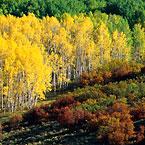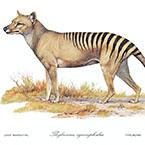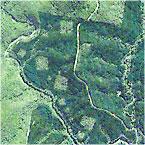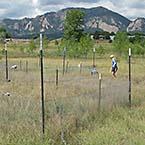Research
Research themes

Species range limits and climate change
For every species, there are limits to where it is found. Understanding what sets range limits and their variability is vital for understanding and forecasting how species will respond to climate change. For example, how fast can species' ranges adjust to a changing climate and to increased variability in climate? Funded by NSF, following from our previous project (below) on single species dynamics, my colleague Alan Hastings (UC Davis) and I are examining how competition between species interacts with a changing environment to shape species' ranges. See our recent paper in PNAS.

Evolutionary rescue
When confronted with a new environment, either because the environment changes or a species is introduced to a new environment, the population is in a race against time to evolve to the new environment before it goes extinct. This process is called evolutionary rescue. With funding from NSF, my colleague Ruth Hufbauer (Colorado State University) and I have been using the Tribolium model system together with mathematical and statistical models to disentangle the relative contributions of demography and genetics in evolutionary rescue. See our recent paper in Proc B and previous papers in Proc B and PNAS.

Habitat fragmentation, megafire and extinction
Habitat loss and fragmentation continue at an accelerating rate and account for most biodiversity loss so it is more crucial than ever to understand them as drivers of extinction. Fortunately, some visionary ecologists at CSIRO Australia (Chris Margules, Mike Austin, Nick Nichols) set up a large scale fragmentation experiment back in 1985. Now 30 years later, it's the longest running experiment in temperate forest. Driven by climate change, the whole site burned in the 2020 megafires. Funded by NSF, my colleague Kendi Davies (EBIO) and I have been following the population dynamics and extinction of forest beetles for many years before, and now after, the fire. For more on this research, see our beautiful website at wogwog.org.

Spread of invading species
Invasive species are a major economic, environmental and health concern. Species like the cane toad, fire ant, or cheatgrass can transform ecosystems and devastate biodiversity. My colleague Alan Hastings (UC Davis) and I have been using the Tribolium model system to investigate the role of stochasticity in the spatial spread of populations and my colleague Ruth Hufbauer (Colorado State University) and I have been investigating how genetics contributes to this stochasticity. See recent papers in Evol Lett, Proc B, PNAS, and Nature Comms, and previous papers in Nature and Science from this work. This project was funded by NSF and our work on range limits above extends this work.

Nutnet - The Nutrient Network
What do you get when you put a bunch of nuts together? Peanut butter? No, these are science nuts, and what you get is great collaborative science. In a new way of way of doing science that has been called open source ecology colleagues from around the world got together to set up a collaborative field experiment, now replicated at more than 70 sites in 12 countries, including our site in Boulder, to understand how ecosystems are changing because of nutrient pollution. Globally, nitrogen input has doubled due to fossil fuel use and phosphorous input has increased five-fold due to agriculture. Nutnet is studying the consequences of these increased inputs to grassland ecosystems. Many papers from our collective effort have appeared in Science, Nature and other top journals.

Scaling up ecological dynamics
A vexing question in ecology is how to predict large scale ecological dynamics from small-scale processes. This is especially important since most of our experimental work in ecology happens in small field plots. Often large-scale outcomes contradict small-scale trends from such field plots. We need to understand why this happens so we can make better predictions in areas as diverse as climate change, extinction, invasion, and biodiversity maintenance. I was fortunate to do my graduate work with Peter Chesson (U. Arizona), who is a leader in this area. The basic theoretical principles underlie most of what I do. Here are two representative papers in the journal Ecology from 2006 and 2016.

